Alan M. Petrillo
Makers of aircraft rescue and firefighting (ARFF) apparatus are continually improving their equipment, upgrading their units’ ease of use, adding safety features and turrets, increasing fire suppression capabilities, and making more nimble vehicles.
ARFF Primer
The Federal Aviation Administration (FAA) developed ARFF vehicle requirements (Class 1 through 5) using National Fire Protection Association (NFPA) 414, Standard for Aircraft Rescue and Fire-Fighting Vehicles, as its baseline, as well as an airport index the FAA uses to rate airports by the length of aircraft using the airport (Index A through E).
Index A includes aircraft less than 90 feet long; Index B, 90 feet but less than 126 feet; Index C, 126 feet but less than 159 feet; Index D, 159 feet but less than 200 feet; and Index E, aircraft at least 200 feet in length.
A Class 1 four-wheel drive diesel ARFF vehicle must carry 100 gallons of water/aqueous film forming foam (AFFF) and 500 pounds of sodium-based or 450 pounds of potassium-based dry chemical, or 460 pounds of halogenated agent. Class 2 ARFF units must carry 300 gallons of water/AFFF and the same dry chem complement required as Class 1. Class 3 ARFF vehicles must carry 500 gallons of water/AFFF and class 1 dry chem requirements.
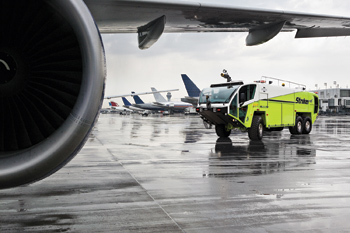 |
| (1) Oshkosh makes the Striker ARFF vehicle with upper, bumper, and under turrets, as well preconnected crosslays in trays. (Photo courtesy of Oshkosh.) |
A Class 4 ARFF vehicle covers a commercially produced diesel-engine-driven unit for an Index B, C, or D airport with a 1,500-gallon water/AFFF fire suppression system and, depending on the airport, a complementary 450- or 500-pound dry chemical and a 460-pound halogenated agent system.
A Class 5 ARFF unit includes a 3,000- to 4,500-gallon water/AFFF fire suppression system and complementary 450- or 500-pound dry chemical and a 460-pound halogenated agent system. Class 5 ARFF vehicles cover Index D and E airports.
Running the Gamut
Marty Huffman, ARFF regional manager for Rosenbauer, says his company covers the entire spectrum in the ARFF market from Class 1 to Class 5 vehicles. He notes that Rosenbauer’s crash trucks are built on the custom Panther chassis with water tanks up to 3,000 gallons (built in the United States) and to 4,500 gallons (built at Rosenbauer’s parent location in Linz, Austria). “Generally the 1,500-gallon ARFF vehicles we build are 4×4 units and the 3,000-gallon ARFFs are 6×6,” Huffman says. “For the Index E airports that use a 4,500-gallon ARFF truck, they are 8×8 units. Examples of those ARFF vehicles can be found at the Los Angeles, California, International Airport.”
Rosenbauer also makes the Air Wolf line of Class 1, 2, and 3 ARFF vehicles, typically on Ford F-550 or International chassis and carrying up to 750 gallons of water.
Huffman says the two primary components on the ARFF units Rosenbauer builds are high-volume low-attack (HVLA) turrets and high-reach extendable turrets (HRET). “In the past five years, there has been a trend toward the HVLA turrets,” Huffman points out. “Many fire departments are removing the roof turret and making the bumper turret the main firefighting turret on the vehicle.”
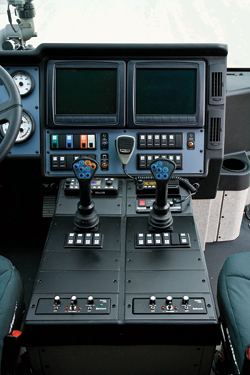 |
| (2) To simplify the cab, firefighting controls in the Striker are located to the right of the driver (note the steering wheel at the far left of the photo) and vehicle controls to the left. (Photo courtesy of Oshkosh.) |
Huffman says an HVLA turret can lower to within 12 inches of the ground, allowing the vehicle operator to attack low spots in an aircraft fire, such as under a wing or in the landing gear area.
For Index C, D, and E airports, Huffman says Rosenbauer has been building ARFF vehicles with HRET units, essentially a boom mounted on top of the vehicle that can extend and penetrate into an aircraft to deliver multiple agents-water, foam, dry chemical, or halogenated agent.
Rosenbauer makes the Stinger, a hydraulic system that builds up to 32,000 pounds of pressure to force a penetrator into the side of the aircraft to deliver fire suppression agents. The system allows the ARFF operator to rotate the penetrator 180 degrees to make positive penetration of the aircraft and not skip off its curved sides.
“Hydrochem technology is now a standard in ARFF vehicles,” Huffman points out. “Usually there’s a high-flow nozzle with a tube in the center of it that allows dry chemical to be discharged simultaneously into the foam-water stream. You get the knockdown of dry chem plus the cooling and sealing effect of water and foam behind it.”
Huffman notes some fire departments have been requesting compressed-air foam system (CAFS) units on both 1,500- and 3,000-gallon ARFF vehicle variations. Huffman says that Ottawa International Airport, in Canada, has two Rosenbauer CAFS ARFF vehicles that can flow CAFS out of their roof turrets, while an ARFF unit at the Burbank Airport, in California, uses a compressed-air stored-energy system on board to produce what he calls “Flash CAFS.”
 |
| (3) The Stinger, built by Oshkosh on a Ford F-550 chassis that meets FAA Class 1 and 2 airport standards, can carry up to 300 gallons of water, a foam tank, up to 500 pounds of dry chem, and 120 pounds of halogenated agent. (Photo courtesy of Oshkosh.) |
Global ARFF
One of the best-known names in ARFF vehicles is the Oshkosh-produced Striker, whose first generation appeared in 2001. Today, Oshkosh builds what it calls the Global Striker, a unit that is compliant to Euro 5 emission levels (a worldwide standard) and also to Environmental Protection Agency (EPA) 2014 emission standards.
Steve Schwartz, Oshkosh’s product manager of ARFF equipment, says the Striker is guided from a performance standpoint not only by NFPA 414 but also by standards promulgated by the International Civil Aviation Organization (ICAO). “We took those standards and user input to make a walk-in engine compartment with a door on each side for easy access,” Schwartz says. “All the filters are easily accessible with a drain pan underneath, and it’s also easy to service bolt-on engine components and electrical components. Any major engine repairs can be made with the engine in the vehicle.”
Schwartz points out that Oshkosh offers the new Striker with preconnected crosslays in trays that will hold up to 300 feet of 1¾-inch hose. “A firefighter pulls the hose, and when it is tugged out completely it activates the water-foam flow, which also can be activated from the cab or the hoselay panel,” he says. “It improves responsiveness on a fire scene because firefighters don’t have to unroll hoses and hook them up.”
Schwartz says the Striker now has a pressure-governed system, where the vehicle’s engine ramps up to pump speed and maintains pressure as flows increase, whether using crosslay handlines, the turret, or the two unregulated 2½-inch discharges on the vehicle.
Oshkosh also took out some of the complications in the ARFF vehicle’s cab, Schwartz adds. “We wanted to simplify things from an operational standpoint,” he says. “We color-coded the buttons in the cab to activate the agent to be applied-blue for water, green for foam, and other colors for secondary agents like dry chemical or Halatron. The operator engages the rocker switch, which is denoted by universal symbols, and after that is ready to pull the trigger.”
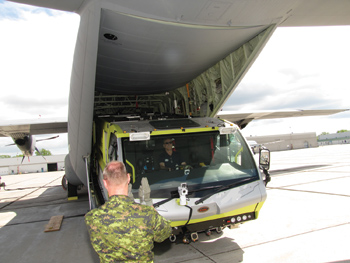 |
| (4) KME built an air-transportable ARFF, a slimmed-down Class 4 vehicle, for the Canadian Department of National Defense. (Photo courtesy of KME.) |
In the Striker cab, from the driver’s center position, all the vehicle controls are on the left of the driver and all the firefighting systems are on the right. The Striker is designed to be operated by a single firefighter. A typical Striker has an upper turret, a bumper turret, and an under turret depending on the customer’s needs. “Either the roof or bumper turret can be the primary one with the larger flow nozzle,” Schwartz says. “On a bumper turret, we offer a low-attack version where the nozzle can drop down and sweep the ground to fight a fire from a different angle. We also offer the Snozzle high-reach extendable turret for the top of the vehicle.”
Oshkosh can install infrared cameras on the vehicle in various body locations or on the monitors and also has designed high-pressure firefighting capability into the Striker.
The Striker is available in a 4×4 chassis carrying 1,500 gallons of water and a 210-gallon foam tank with a 50-foot Snozzle, Schwartz says. The Striker 6×6 model typically has 3,000 gallons of water, a 420-gallon foam tank, and either a 50- or a 65-foot Snozzle, while the 8×8 Striker is available with up to 4,500 gallons of water, 630 gallons of foam, and either a 50- or a 65-foot Snozzle. Both the 6×6 and 8×8 Strikers are available in rear-steer versions.
Oshkosh also makes the Stinger, usually built on a Ford F-550 chassis, that meets FAA Class 1 and 2 vehicle requirements. It can carry up to 300 gallons of water, a foam tank, up to 500 pounds of dry chemical powder, and 120 pounds of halogenated agent. “The Stinger fills the niche for smaller airports and is useful where municipal fire departments are responsible to protect an airport,” Schwartz points out. “The vehicle has a structural firefighting capability, as well as a front-bumper turret and full pump-and-roll ability.”
Customized ARFF Units
Dave Krajnak, airport product manager for KME, says that this year has been a busier year for building ARFF units than 2011. KME builds all five classes of ARFF vehicles and is able to customize them to the user’s requirements. “One of our most successful configurations recently is an air-transportable design developed for the Canadian Department of National Defense,” Krajnak says. “We delivered four units to them and three are stationed near the North Pole. The United States Navy recently awarded us a contract for a version of that vehicle because they needed a truck smaller than the standard ARFF vehicle.”
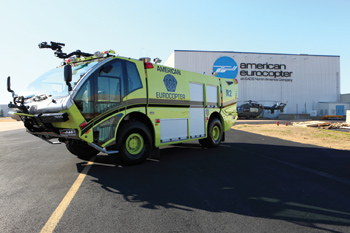 |
| (5) This KME Force 1500 Class 4 vehicle was built for American Eurocopter in Grand Prairie, Texas. (Photo courtesy of KME.) |
The Canadian air transportable ARFF is a slimmed-down Class 4 vehicle, Krajnak says, “carrying just shy of 1,300 gallons of water and 130 gallons of foam.” The vehicle being built for the United States Navy is a typical Class 4, he notes-a 4×4 carrying 1,500 gallons of water and 200 gallons of foam.
Krajnak notes that the predominant requirement of the ARFF market is for Class 5 vehicles of 6×6 or 8×8 configurations. “Class 4 vehicles end up in the smaller airports or for special requirements,” he adds. “More than 80 percent of the bids we receive are for Class 5 vehicles in 6×6 or larger.”
While automotive performance capabilities have changed dramatically over the years in terms of emission requirements, acceleration, and roof strengths, the way ARFF vehicles pump water and deliver foam hasn’t changed much, Krajnak points out. “They are designed to deliver a lot of water at a reasonable gpm and carry a certain complement of foam and dry chem, but it’s not much different than 20 years ago,” he says. “But, there are technologies being evaluated, especially by military entities, in the ultra-high-pressure (UHP) field. The United States Air Force has a UHP program with the goal to have as small a truck as possible. They are using far less agent and fighting fires with less foam and water, which could lead to a truck smaller in size.”
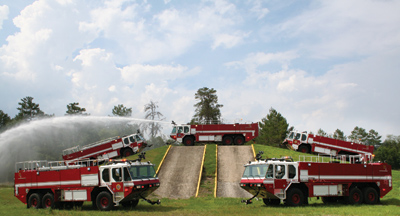 |
| (6) E-ONE built these five 6×6 Titan 4 ARFF vehicles for the United States Navy. (Photo courtesy of E-ONE.) |
Customer-Driven
R.J. Jones, E-ONE’s sales manager for United States government and airport products, says his company has seen incremental improvements in the ARFF markets for three types of customers: United States airports, military firefighting units, and international firefighting units.
E-ONE offers the 4×4 Titan Force ARFF that carries 1,585 gallons of water, as well as a 6×6 version hauling 3,170 gallons of water. The Titan Force P-7 series typically is driven by a Cummins 665-hp QSX-15 diesel engine and an Allison EVS 4800 transmission and carries a Hale RSD 1,500-gpm pump on a 4×4 unit and a Hale RME 2,400-gpm pump on the 6×6. Foam tanks are 205 gallons on the 4×4 and 405 gallons on the 6×6, and both carry dry chemical and a halogenated agent.
“We’ve been moving away from building 8×8 vehicles even though we’ve built them in the past,” Jones says. “Today, the majority of our business is customer-driven in the 4×4 and 6×6 ARFF vehicles.”
Jones says features of E-ONE ARFF vehicles include the Rhino low-attack turret (which E-ONE purchased from Crash Rescue), a nitrogen bottle lift integrated into the vehicles’ bodies for changing propellant bottles, spacious compartmentation, external pump panels and plumbing connections for ease of use with mutual-aid companies, and updated cab layouts with attention to ergonomics.
 |
| (7) One of the features of E-ONE’s Titan 4 ARFF apparatus is a nitrogen bottle lift that’s integrated into the vehicle’s body to make changing propellant bottles easier and safer. (Photo courtesy of E-ONE.) |
Grady North, E-ONE’s product manager for pumpers, industrial and ARFF, says the company has been installing more side- and rear-mounted electronic components on its ARFF vehicles, as well as seat belt indicator systems, tire-pressure-monitoring systems, and forward incident recording camera systems. “We’re also improving the multiplexing systems on the vehicles,” he notes, “to allow adding these features without having to change the wiring harnesses.”
ALAN M. PETRILLO is a Tucson, Arizona-based freelance writer and is a member of the Fire Apparatus & Emergency Equipment editorial advisory board. He served 22 years with the Verdoy (NY) Fire Department, including in the position of chief.

